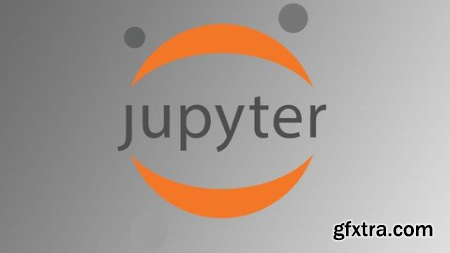
Published 2/2023MP4 | Video: h264, 1280x720 | Audio: AAC, 44.1 KHzLanguage: English | Size: 1.08 GB | Duration: 1h 29m
Learn the Basics of Jupyter Notebook, Data Manipulation, Visualization, and Collaboration in Python Environment What you'll learn Installing and setting up Jupyter Notebook on their computer. Creating, opening, and saving Jupyter notebooks. Navigating the Jupyter Notebook interface and working with cells. Executing Python code in Jupyter Notebook and working with variables. Using Markdown to format text and create headings, lists, and tables. Importing external libraries and modules. Perfog basic data manipulation and analysis with Python Collaborating with others by sharing and exporting notebooks. Requirements Basic knowledge of Python programming language Familiarity with data analysis and visualization Basic knowledge of HTML and Markdown Description Jupyter Notebook is a popular open-source web application that is widely used by data scientists, analysts, and researchers to create and share documents that contain live code, equations, visualizations, and narrative text. It is an interactive data science environment that allows users to explore, manipulate, and visualize data in real-. Jupyter Notebook is built on top of Python, but it also supports other popular programming languages such as R and Julia.This short course is designed to provide an introduction to Jupyter Notebook and to help you get started with basic data science tasks using this powerful tool. In this course, you will learn how to install and set up Jupyter Notebook on your computer, create and execute code cells in Python, perform data manipulation and analysis using popular Python libraries.Installing and Setting up Jupyter NotebookThe course will start by showing you how to install and set up Jupyter Notebook on your computer. You will learn how to create a new notebook, how to add and delete cells, and how to execute code cells. You will also learn how to save and your notebooks, and how to share them with others.Data Manipulation and Analysis with PythonIn the next section of the course, you will learn how to perform data manipulation and analysis using popular Python libraries. You will learn how to read in data from different sources, how to clean and transform data, and how to perform basic statistical analysis.Collaboration and Sharing with Jupyter NotebookFinally, in the last section of the course, you will learn how to collaborate with others by sharing and exporting your notebooks.ConclusionBy the end of this course, you will have a solid understanding of Jupyter Notebook and be able to use it to perform basic data science tasks. Jupyter Notebook is a powerful tool for data exploration, analysis, and visualization, and it is widely used by data scientists, analysts, and researchers around the world. Whether you are just getting started with data science or you are an experienced data scientist, Jupyter Notebook is a tool that you should have in your toolkit. Overview Section 1: Introduction Lecture 1 Introduction Lecture 2 Agenda Lecture 3 What is a Notebook Lecture 4 What is a Jupyter Notebook Lecture 5 Jupyter notebook User Interface Lecture 6 Jupyter Notebook and Research Lecture 7 Jupyter notebook for Data Science Lecture 8 Key features of Jupyter Notebook Lecture 9 Who uses the Jupyter Notebook? Lecture 10 Setup & Installation Lecture 11 Install ssing Pip Lecture 12 Setup using Anaconda Lecture 13 Dashboard Lecture 14 First Notebook Lecture 15 What is Kernel Lecture 16 Shortcuts in Jupyter Notebook Lecture 17 Demo Part#1 Lecture 18 Go through Lecture 19 Benefits of using Jupyter Notebook Lecture 20 Summary Data scientists and analysts: Jupyter Notebook is a popular tool for data science and analysis. Data scientists and analysts who are new to Jupyter Notebook can benefit from an introductory course to learn how to use the tool effectively for data exploration, visualization, and analysis.,Researchers: Jupyter Notebook can be used to conduct and share research in various fields, such as computational biology, neuroscience, and physics. Researchers who are new to Jupyter Notebook can benefit from an introductory course to learn how to use the tool to organize, analyze, and share their research.,Programmers and developers: Jupyter Notebook can be used as a development environment for various programming languages, such as Python, R, and Julia. Programmers and developers who are new to Jupyter Notebook can benefit from an introductory course to learn how to use the tool for prototyping, testing, and debugging code.,Students and educators: Jupyter Notebook is an excellent tool for teaching and learning various concepts and skills related to data science, machine learning, and programming. Students and educators who are new to Jupyter Notebook can benefit from an introductory course to learn how to use the tool to create interactive and engaging learning materials.,Anyone interested in coding and data analysis: Jupyter Notebook is a versatile tool that can be used for various applications that involve coding and data analysis. Anyone who is interested in coding and data analysis can benefit from an introductory course to learn how to use Jupyter Notebook effectively. HomePage:
Top Rated News
- Sean Archer
- AwTeaches
- Learn Squared
- PhotoWhoa
- Houdini-Course
- Photigy
- August Dering Photography
- StudioGuti
- Creatoom
- Creature Art Teacher
- Creator Foundry
- Patreon Collections
- Udemy - Turkce
- BigFilms
- Jerry Ghionis
- ACIDBITE
- BigMediumSmall
- Boom Library
- Globe Plants
- Unleashed Education
- The School of Photography
- Visual Education
- LeartesStudios - Cosmos
- All Veer Fancy Collection!
- All OJO Images
- All ZZVe Vectors




